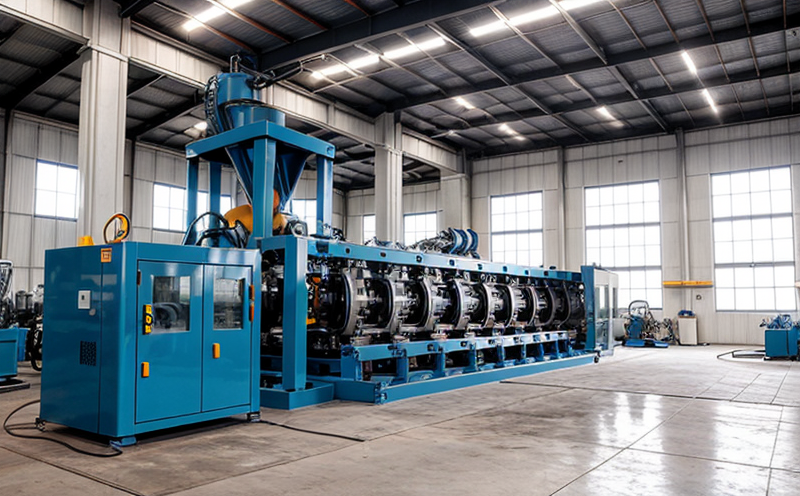ASTM E10 Brinell Hardness Performance Testing of Equipment Metals
The ASTM E10 Brinell hardness test is a widely recognized method used to determine the hardness of various metals and alloys. This testing technique involves pressing a hardened steel ball or carbide indenter into the surface of the material under a specific load, then measuring the diameter of the indentation left behind. The resulting pressure creates a permanent mark that provides valuable insights into the mechanical properties of materials.
The Brinell hardness test is particularly useful for assessing the hardness of large parts and thick sections where other methods may be impractical or less reliable. In industrial manufacturing, this test ensures that critical components like gears, shafts, bearings, and casings meet required specifications. Compliance with international standards such as ASTM E10 ensures that products are consistent in quality across different manufacturers and regions.
The process begins by selecting the appropriate indenter size and load based on the material type and expected hardness range. After applying the load for a specified duration, the indentation is measured using a calibrated microscope or optical comparator. The Brinell hardness number (HB) is calculated as follows:
\[ HB = \frac{2P}{\pi D(d - L)} \]Where \( P \) is the applied load in kilograms-force, \( d \) is the diameter of the indentation, and \( L \) is the depth of the indentation. This calculation provides a dimensionless value that allows for easy comparison between different materials.
The Brinell hardness test is often used during product development to optimize material selection and design. By testing various samples under controlled conditions, engineers can identify the best combination of strength, ductility, and resistance to wear and corrosion. This information is crucial when specifying materials for high-stress applications where durability plays a significant role.
Moreover, regular Brinell hardness testing during production ensures that manufacturing processes are consistent and produce parts meeting quality standards. Quality managers can use this data to make informed decisions about process adjustments or material changes if inconsistencies arise.
The ASTM E10 method is not only used in product design but also plays a key role in ensuring equipment longevity and performance. By monitoring the hardness of components over time, maintenance teams can anticipate potential wear and tear issues, schedule timely replacements, and extend the operational life of machinery. This proactive approach helps minimize downtime and associated costs.
| Indenter Size (mm) | Load Range (kgf) | Recommended Materials |
|---|---|---|
| 10 mm | 300-800 kgf | Mild steel, cast iron, brass |
| 12.5 mm | 600-2000 kgf | Steel alloys, stainless steel |
| 18 mm | 900-3000 kgf | Copper and its alloys, aluminum |
In summary, ASTM E10 Brinell hardness testing is an essential tool in industrial manufacturing for ensuring the quality and performance of machinery and equipment. Its ability to provide precise measurements allows manufacturers to optimize material choices, monitor production processes, and maintain reliable equipment.
Benefits
The ASTM E10 Brinell hardness test offers several key benefits that are critical for quality assurance in industrial manufacturing:
- Non-destructive testing: The method allows for repeated tests without damaging the material, making it suitable for ongoing quality control.
- Predictive maintenance: By regularly monitoring hardness levels, equipment can be maintained before issues arise, reducing unscheduled downtime.
- Material optimization: Engineers can identify optimal materials and process conditions to enhance product performance and longevity.
- Compliance verification: Meeting international standards ensures that products meet regulatory requirements and industry best practices.
The Brinell hardness test also facilitates collaboration between suppliers, manufacturers, and end-users. By adhering to ASTM E10 guidelines, all parties can ensure consistent quality across the supply chain.
Industry Applications
| Material Type | Indenter Size (mm) | Load Range (kgf) |
|---|---|---|
| Mild steel | 10 mm | 300-800 kgf |
| Cast iron | 10 mm | 300-800 kgf |
| Steel alloys | 12.5 mm | 600-2000 kgf |
| Stainless steel | 12.5 mm | 600-2000 kgf |
The ASTM E10 Brinell hardness test is widely used across various industries, including automotive, aerospace, construction, and manufacturing. In the automotive sector, for instance, it ensures that components like engine blocks, transmission gears, and brake systems meet stringent durability standards.
In aerospace applications, the test verifies the integrity of critical parts such as turbine blades and landing gear. In construction, it helps maintain quality in heavy machinery used in infrastructure projects. For manufacturers, the Brinell hardness test is indispensable for ensuring that every part meets industry specifications and performs optimally under operational conditions.
International Acceptance and Recognition
The ASTM E10 Brinell hardness test enjoys widespread acceptance and recognition globally. It is widely adopted by quality assurance departments, research institutions, and regulatory bodies due to its reliability and repeatability.
The method complies with international standards such as ASTM E10, ISO 6508-2, and EN 10376. These standards provide uniform guidelines for performing the test, ensuring that results are comparable across different laboratories worldwide. Compliance with these standards is crucial for manufacturers who export products to countries with strict quality control regulations.
Many industries rely on ASTM E10 Brinell hardness testing because it offers a robust and standardized approach to evaluating material properties. This consistency enhances trust between suppliers, buyers, and end-users, fostering efficient supply chains and collaborative innovation.





